Experimental Study on Flammability and Flame Spread Characteristics of Polyvinyl Chloride (PVC) Cable
Abstract
:1. Introduction
2. Experimental Materials, System, and Method
3. Results and Discussion
3.1. Flame Shape and Flame Size
3.2. Flame-Spread Rate
3.3. Temperature Distribution
4. Conclusions
Author Contributions
Funding
Acknowledgments
Conflicts of Interest
References
- Zhang, Y.; Chen, X.; Zhang, H.; Liu, J.; Zhang, C.; Jiao, J. Analysis on the Temperature Field and the Ampacity of XLPE Submarine HV Cable Based on Electro-Thermal-Flow Multiphysics Coupling Simulation. Polymers 2020, 12, 952. [Google Scholar] [CrossRef] [PubMed] [Green Version]
- Huang, X.J.; Zhu, H.; Peng, L.; Zheng, Z.H.; Zeng, W.Y.; Bi, K.; Cheng, C.H.; Chow, W.K. Thermal Characteristics of Vertically Spreading Cable Fires in Confined Compartments. Fire Technol. 2019, 55, 1849–1875. [Google Scholar] [CrossRef]
- Mi, H.; Liu, Y.; Jiao, Z.; Wang, W.; Wang, Q. A numerical study on the optimization of ventilation mode during emergency of cable fire in utility tunnel. Tunn. Undergr. Space Technol. 2020, 100, 103403. [Google Scholar] [CrossRef]
- Sarazin, J.; Bachelet, P.; Bourbigot, S. Fire behavior of simulated low voltage intumescent cables with and without electric current. J. Fire Sci. 2017, 35, 179–194. [Google Scholar] [CrossRef] [Green Version]
- Moinuddin, K.; Razzaque, Q.S.; Thomas, A. Numerical Simulation of Coupled Pyrolysis and Combustion Reactions with Directly Measured Fire Properties. Polymers 2020, 12, 2075. [Google Scholar] [CrossRef]
- Fernandez-Pello, A.; Hasegawa, H.; Staggs, K.; Lipska-Quinn, A.; Alvares, N. A study of the fire performance of electrical cables. Fire Saf. Sci. 1991, 3, 237–247. [Google Scholar] [CrossRef] [Green Version]
- Gong, T.; Xie, Q.Y.; Huang, X.Y. Fire behaviors of flame-retardant cables part I: Decomposition, swelling and spontaneous ignition. Fire Saf. J. 2018, 95, 113–121. [Google Scholar] [CrossRef]
- Xie, Q.Y.; Zhang, H.P.; Tong, L. Experimental study on the fire protection properties of PVC sheath for old and new cables. J. Hazard. Mater. 2010, 179, 373–381. [Google Scholar] [CrossRef]
- Wang, Z.; Wang, J. A comprehensive study on the flame propagation of the horizontal laboratory wires and flame-retardant cables at different thermal circumstances. Process Saf. Environ. Prot. 2020, 139, 325–333. [Google Scholar] [CrossRef]
- Wang, Z.; Wei, R.; Wang, X.; He, J.; Wang, J. Pyrolysis and combustion of polyvinyl chloride (PVC) sheath for new and aged cables via thermogravimetric analysis-fourier transform infrared (TG-FTIR) and calorimeter. Materials 2018, 11, 1997. [Google Scholar] [CrossRef] [Green Version]
- Beji, T.; Merci, B.; Verstockt, S.; Zavaleta, P. Flame spread monitoring and estimation of the heat release rate from a cable tray fire using video fire analysis (VFA). Fire Technol. 2015, 52, 611–621. [Google Scholar] [CrossRef] [Green Version]
- Siemon, M.; Riese, O.; Forell, B.; Krönung, D.; Klein-Heßling, W. Experimental and numerical analysis of the influence of cable tray arrangements on the resulting mass loss rate and fire spreading. Fire Mater. 2019, 43, 497–513. [Google Scholar] [CrossRef]
- Huang, X.Y.; Nakamura, Y. A review of fundamental combustion phenomena in wire fires. Fire Technol. 2020, 56, 315–360. [Google Scholar] [CrossRef]
- Palin, L.; Rombolà, G.; Milanesio, M.; Boccaleri, E. The Use of POSS-Based Nanoadditives for Cable-Grade PVC: Effects on Its Thermal Stability. Polymers 2019, 11, 1105. [Google Scholar] [CrossRef] [PubMed] [Green Version]
- Klapiszewski, Ł.; Tomaszewska, J.; Skórczewska, K.; Jesionowski, T. Preparation and Characterization of Eco-Friendly Mg(OH)2/Lignin Hybrid Material and Its Use as a Functional Filler for Poly(Vinyl Chloride). Polymers 2017, 9, 258. [Google Scholar] [CrossRef] [PubMed]
- Nguyen, Q.T.; Ngo, T.D.; Tran, P.; Mendis, P.; Bhattacharyya, D. Influences of clay and manufacturing on fire resistance of organoclay/thermoset nanocomposites. Compos. Part A 2015, 74, 26–37. [Google Scholar] [CrossRef]
- Nguyen, Q.T.; Ngo, T.D.; Bai, Y.; Tran, P. Experimental and numerical investigations on the thermal response of multilayer glass fibre/unsaturated polyester/organoclay composite. Fire Mater. 2016, 40, 1047–1069. [Google Scholar] [CrossRef]
- Ferdous, W.; Ngo, T.D.; Nguyen, K.T.; Ghazlan, A.; Mendis, P.; Manalo, A. Effect of fire-retardant ceram powder on the properties of phenolic-based GFRP composites. Compos. Part B 2018, 155, 414–424. [Google Scholar] [CrossRef]
- Shan, X.; Jiang, K.; Li, J.; Song, Y.; Han, J.; Hu, Y. Preparation of Cyclodextrin Inclusion Complex and Its Application as an Intumescent Flame Retardant for Epoxy. Polymers 2019, 11, 71. [Google Scholar] [CrossRef] [Green Version]
- Zhang, Z.; Yuan, L.; Guan, Q.; Liang, G.; Gu, A. Synergistically building flame retarding thermosetting composites with high toughness and thermal stability through unique phosphorus and silicone hybridized graphene oxide. Compos. Part A 2017, 98, 174–183. [Google Scholar] [CrossRef]
- Song, K.; Wang, Y.; Ruan, F.; Liu, J.; Li, N.; Li, X. Effects of a Macromolecule Spirocyclic Inflatable Flame Retardant on the Thermal and Flame Retardant Properties of Epoxy Resin. Polymers 2020, 12, 132. [Google Scholar] [CrossRef] [PubMed] [Green Version]
- Plumecocq, W.; Audouin, L.; Zavaleta, P. Horizontal cable tray fire in a well-confined and mechanically ventilated enclosure using a two-zone model. Fire Mater. 2019, 43, 530–542. [Google Scholar] [CrossRef]
- Zhao, Y.L. Study on Effects of Pressure and Oxygen Concentration on Flame Spread and Combustion Characteristics of PE-Coated Electric Wire. Ph.D. Thesis, University of Science and Technology, Hefei, China, 2018. [Google Scholar]
- He, H.; Zhang, Q.; Tu, R.; Zhao, L.; Liu, J.; Zhang, Y. Molten thermoplastic dripping behavior induced by flame spread over wire insulation under overload currents. J. Hazard. Mater. 2016, 320, 628–634. [Google Scholar] [CrossRef] [PubMed]
- Zhang, Y. Flame Spread Behavior Characteristics Over Typical Charring Solid Surfaces. Ph.D. Thesis, University of Science and Technology, Hefei, China, 2012. [Google Scholar]
- Williams, F.A. Combustion Theory; Benjamin Cummings: Menlo Park, CA, USA, 1985. [Google Scholar]
- Zhao, W. Study on Pyrolysis and Combustion Characteristics of MSW and Incineration Experiment with Co-Current Shaft Furnace. Ph.D. Thesis, Northeastern University, Shenyang, China, 2012. [Google Scholar]
- Quintiere, J. Fundamentals of Fire Phenomena; John Wiley & Sons: Hoboken, NJ, USA, 2006. [Google Scholar]
- Modak, A.T.; Croce, P.A. Plastic pool fires. Combust. Flame 1977, 30, 251–265. [Google Scholar] [CrossRef]
- Higuera, F.J. Flame spread along horizontal solid fuel cylinders. Proc. Combust. Inst. 2002, 29, 211–217. [Google Scholar] [CrossRef]
- Magalie, C.; Anne-Sophie, C.; Rodolphe, S.; Laurent, F.; Emmanuelle, G.; Christian, L. Fire behaviour of electrical cables in cone calorimeter: Influence of cables structure and layout. Fire Saf. J. 2018, 99, 12–21. [Google Scholar] [CrossRef]
- Kamikawa, D.; Weng, W.G.; Kagiya, K.; Fukuda, Y.; Mase, R.; Hasemi, Y. Experimental study of merged flames from multifire sources in propane and wood crib burners. Combust. Flame 2005, 142, 17–23. [Google Scholar] [CrossRef]
- Lu, Y. Studies on Effects of Environment Wind Velocity and Wire Separation Distance on Flame Spread Behaviors. Ph.D. Thesis, University of Science and Technology, Hefei, China, 2019. [Google Scholar]
- Wang, P.; Zhu, G.; Pan, R.; Chu, T.; Wang, Z.; Liu, H. Effects of curved sidewall on maximum temperature and longitudinal temperature distribution induced by linear fire source in utility tunnel. Case Stud. Therm. Eng. 2020, 17, 100555. [Google Scholar] [CrossRef]
- Zhang, Y.; Tang, K.; Liu, Z.; Chen, Y. Experimental study on thermal and fire behaviors of energized pe-insulated wires under overload currents. J. Therm. Anal. Calorim. 2020. [Google Scholar] [CrossRef]
- Huang, X.; Zhu, H.; Peng, L.; Zheng, Z.; Zeng, W.; Cheng, C.; Chow, W. An improved model for estimating heat release rate in horizontal cable tray fires in open space. J. Fire Sci. 2018, 36, 275–290. [Google Scholar] [CrossRef]
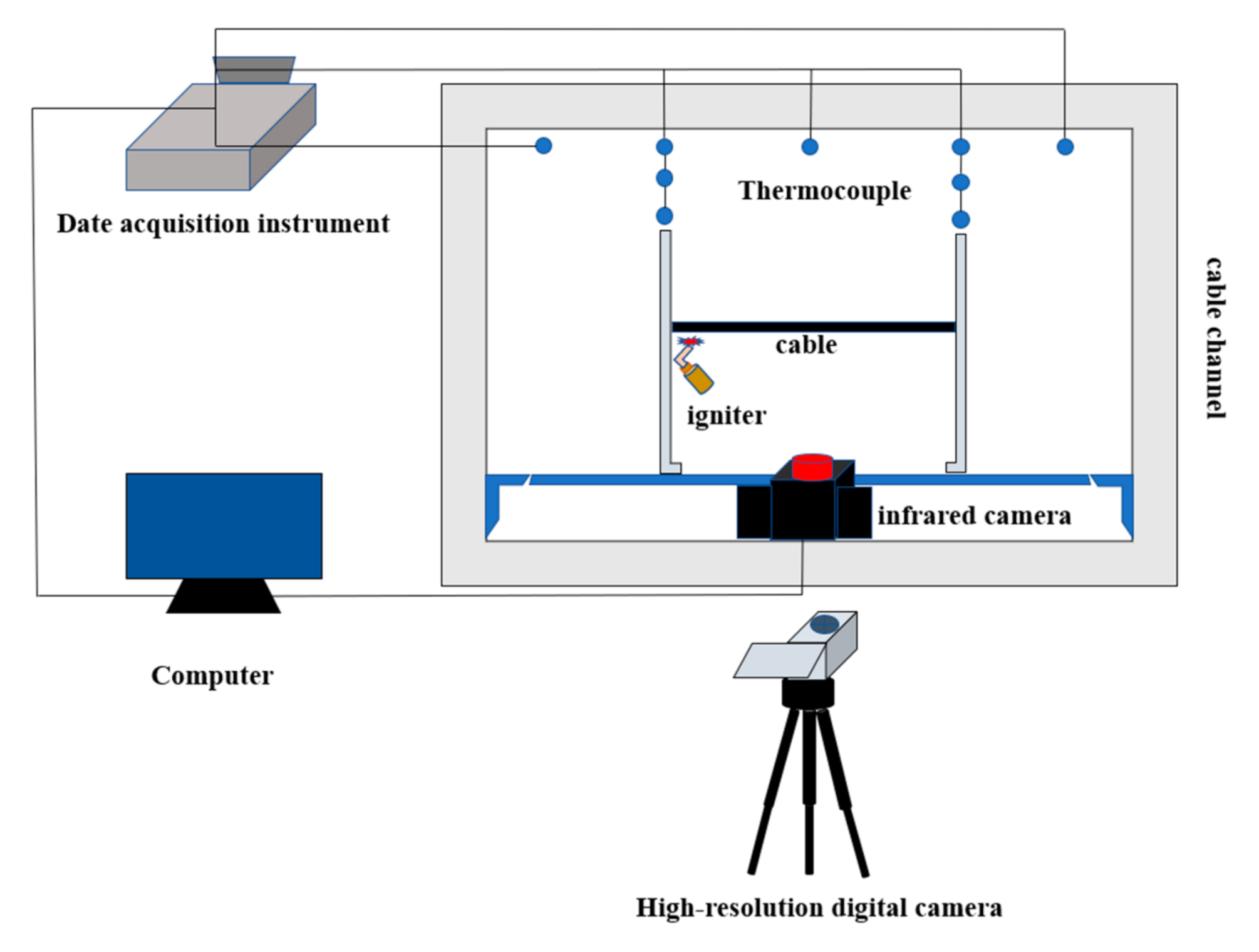

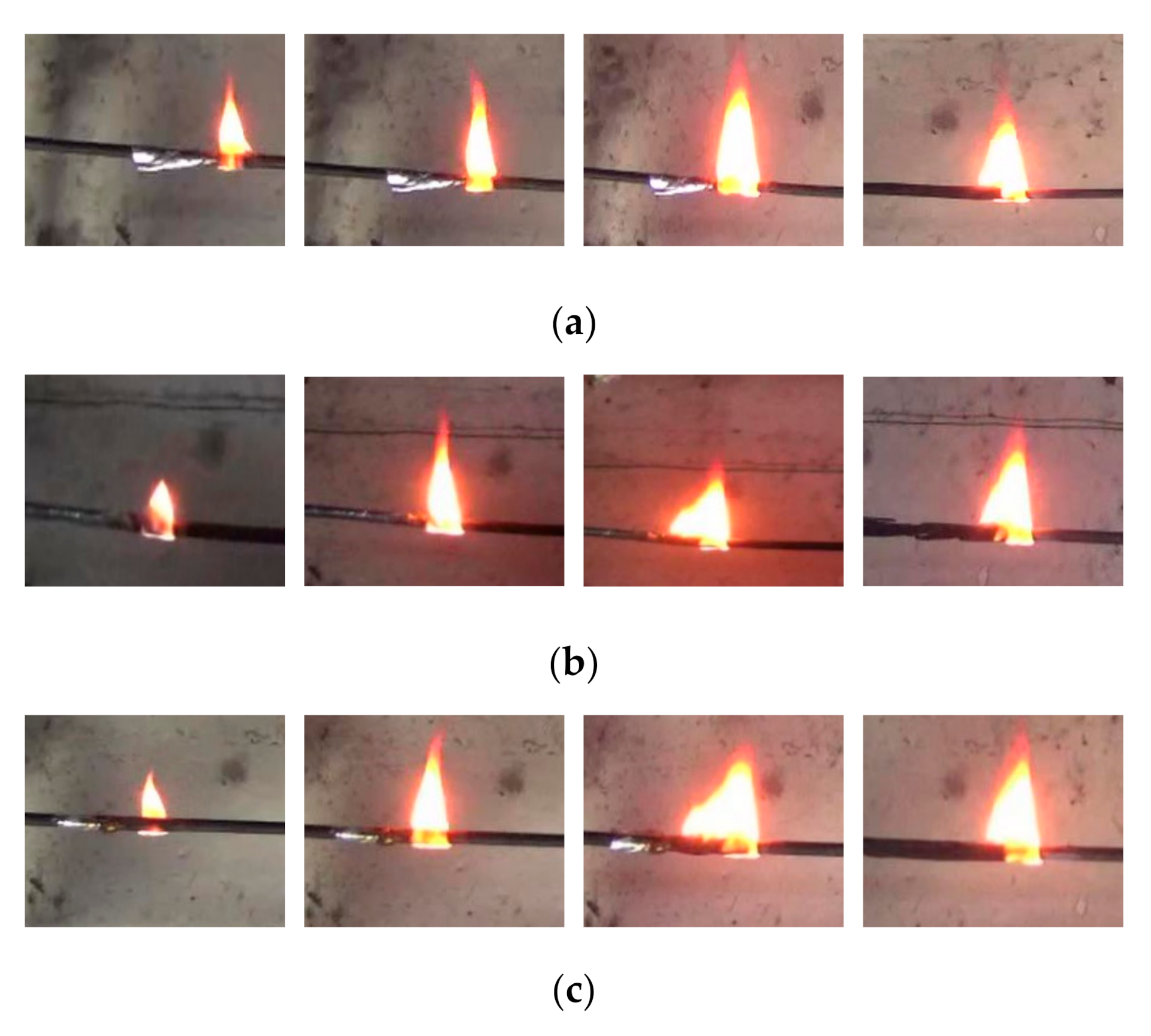
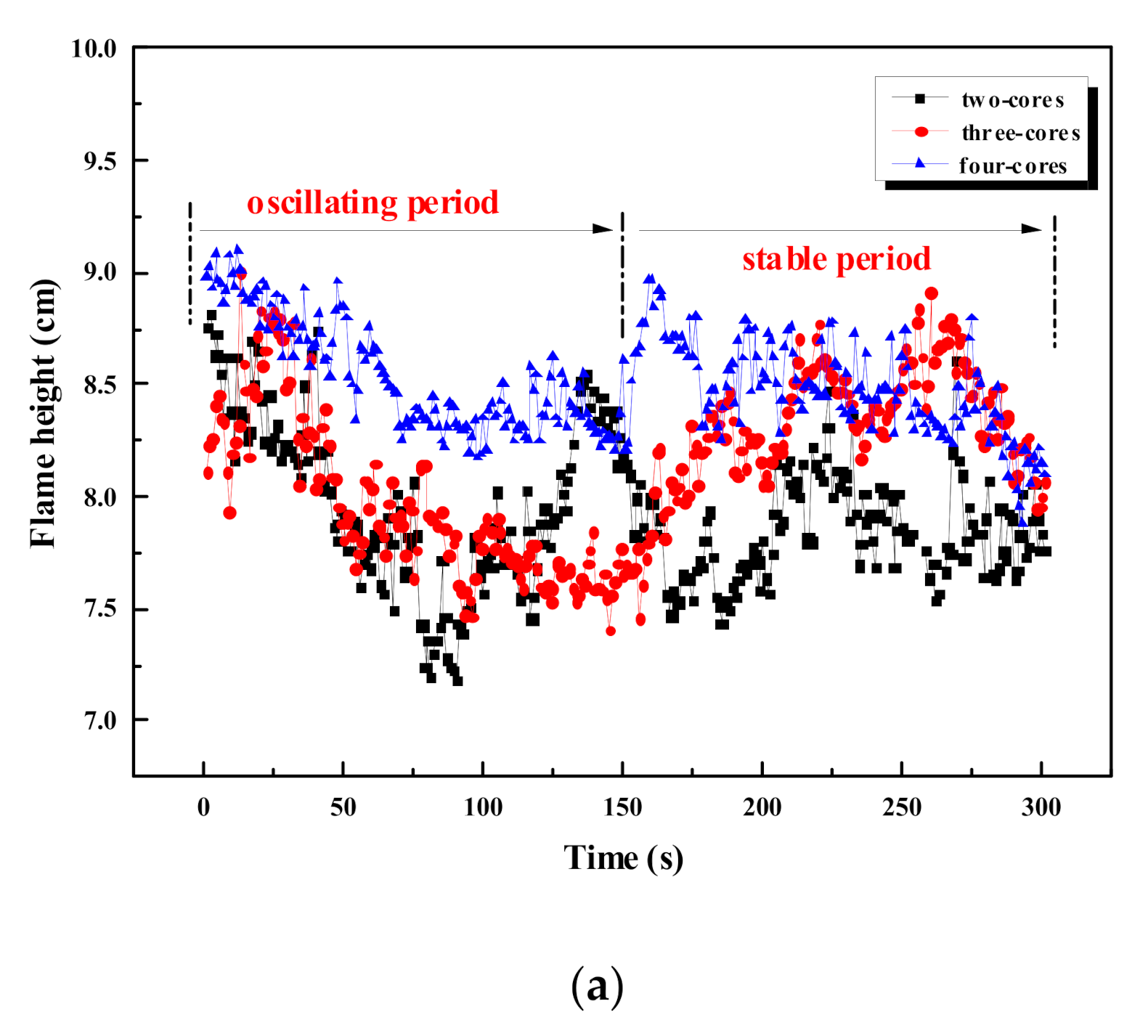
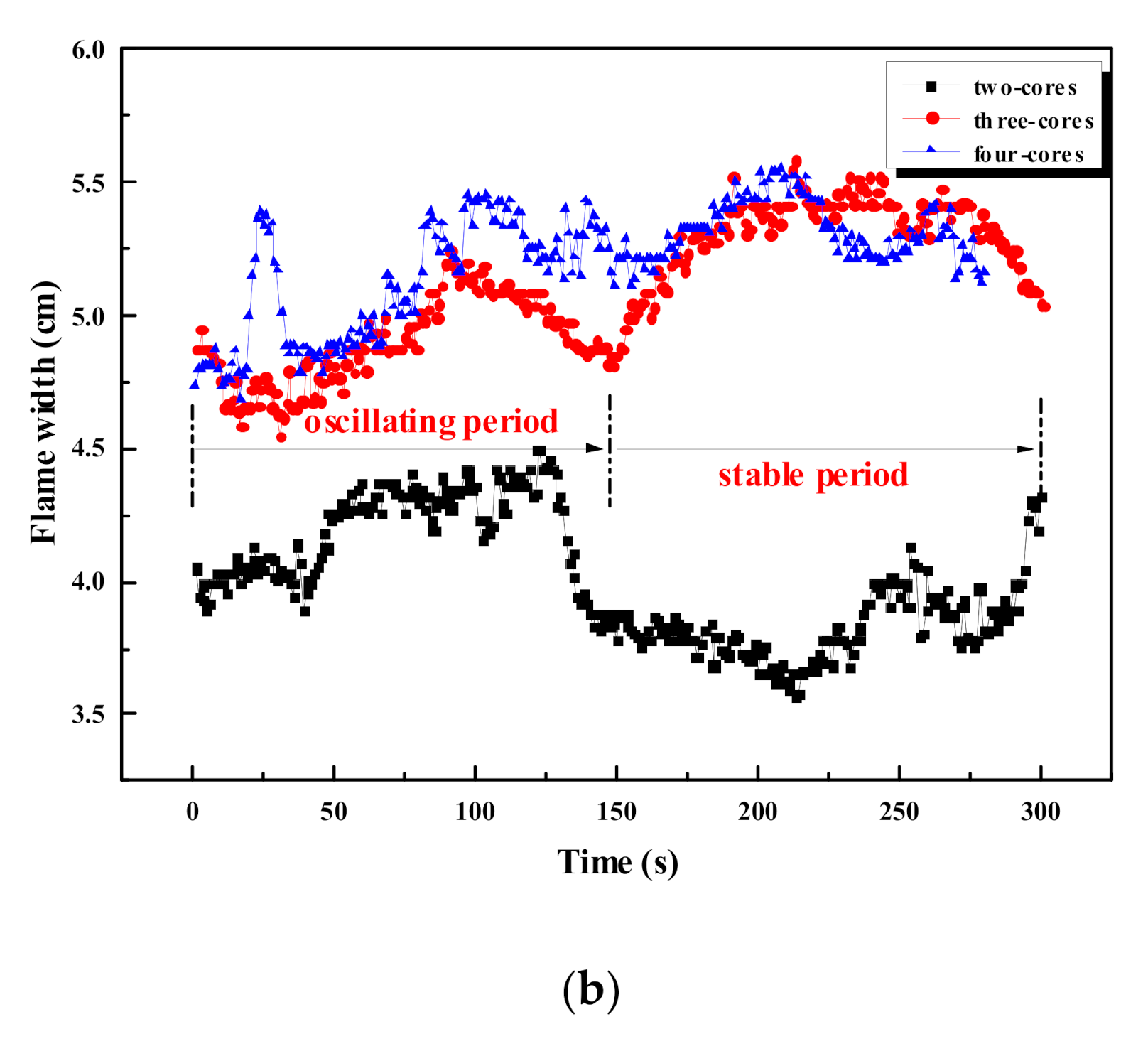
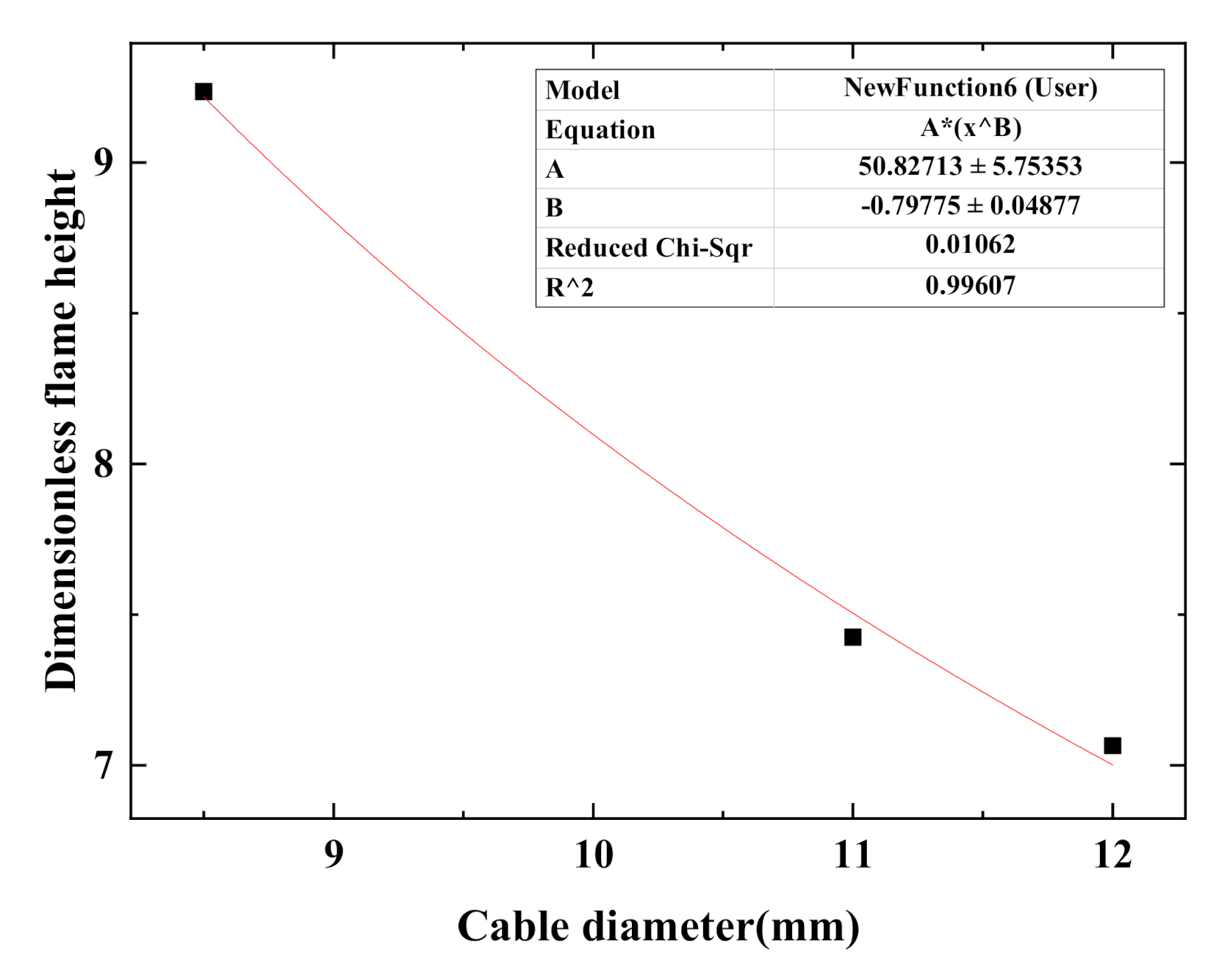

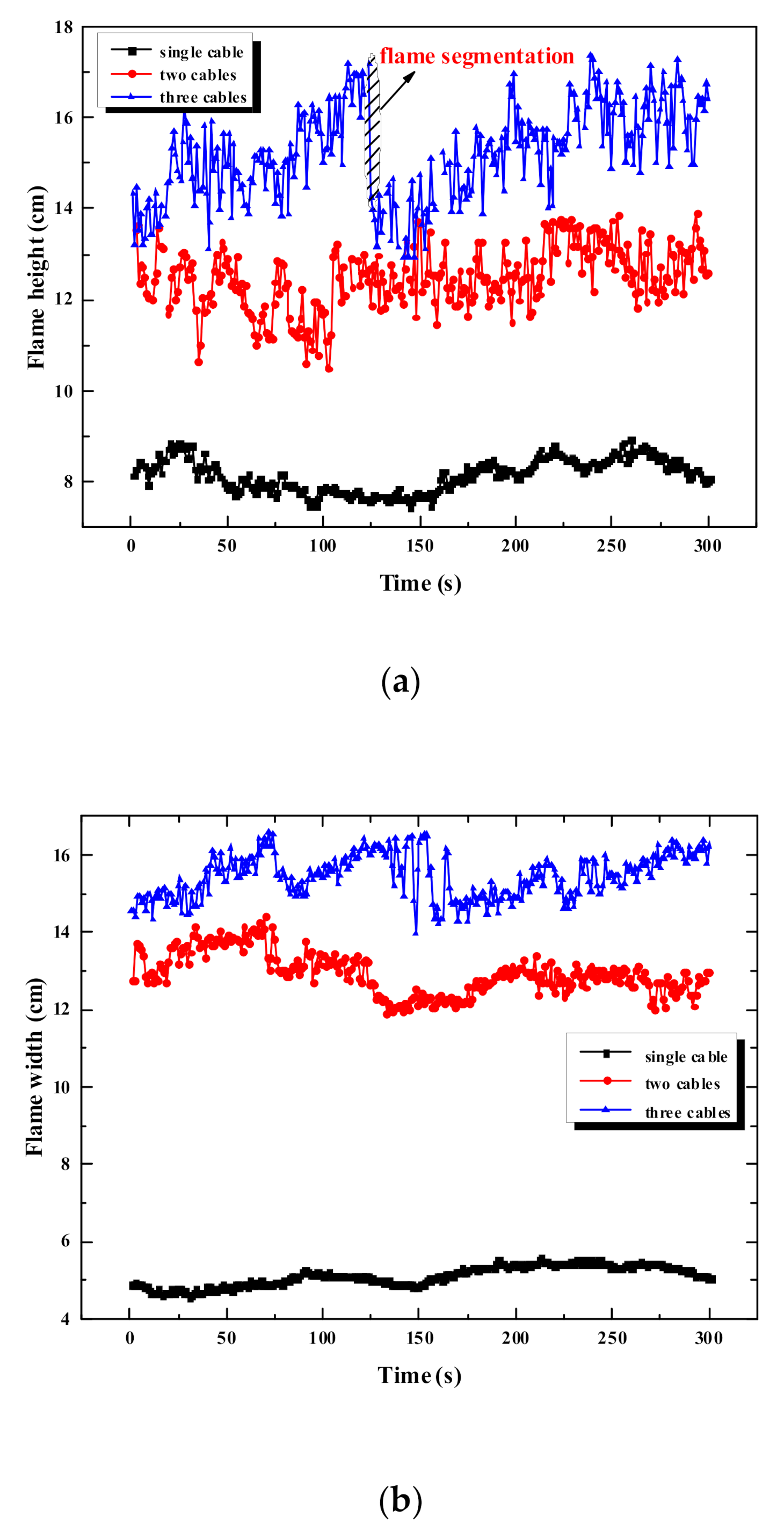
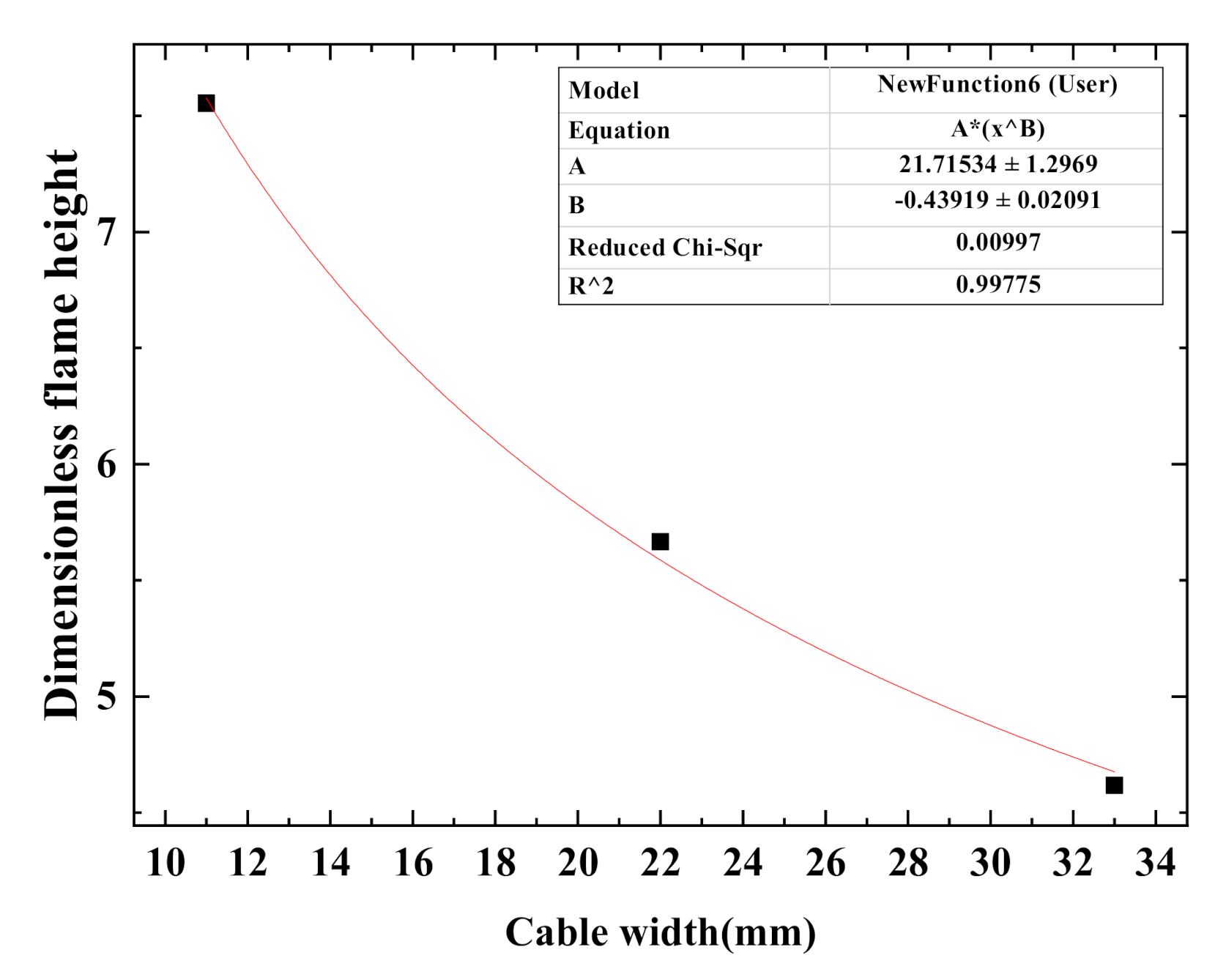

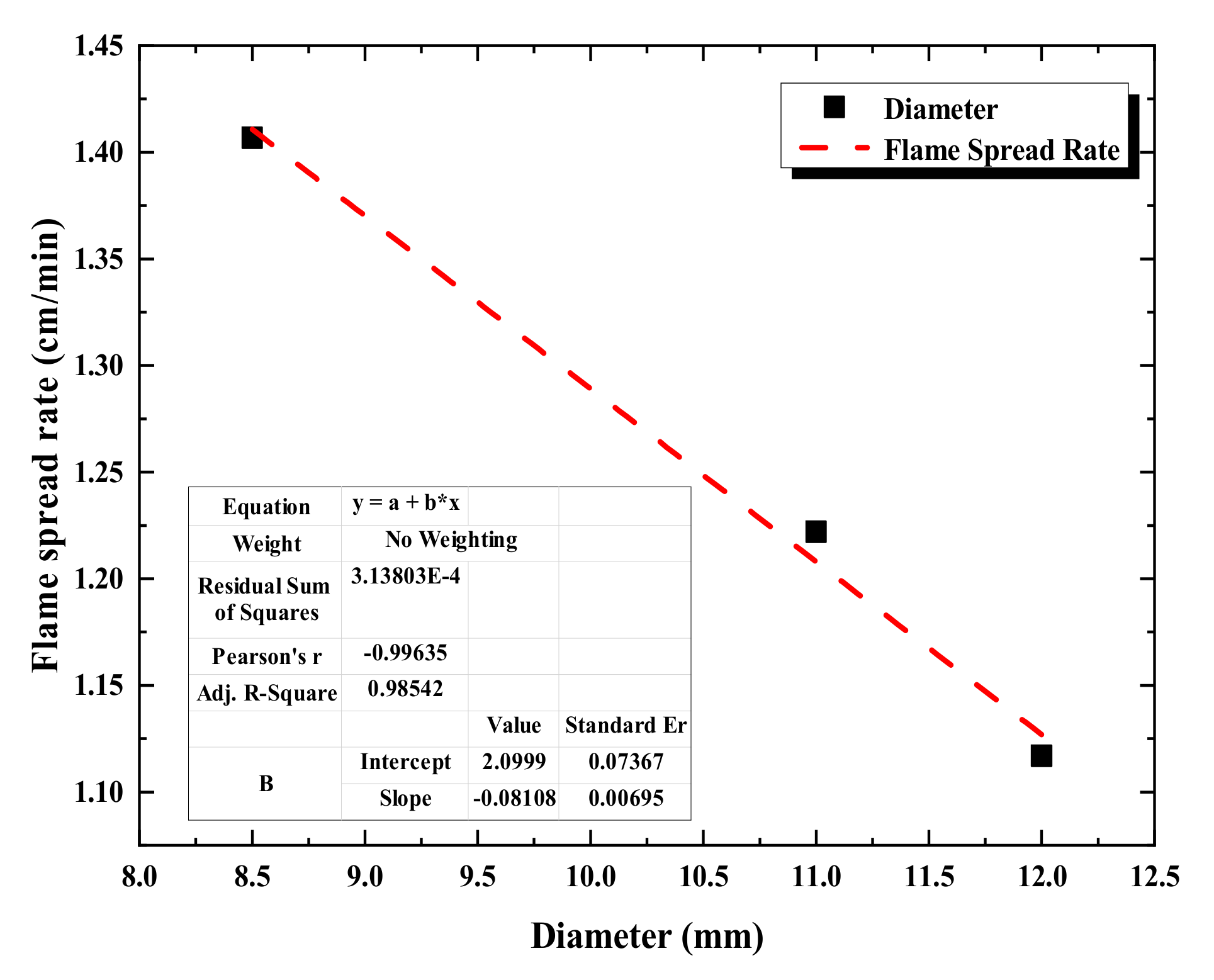
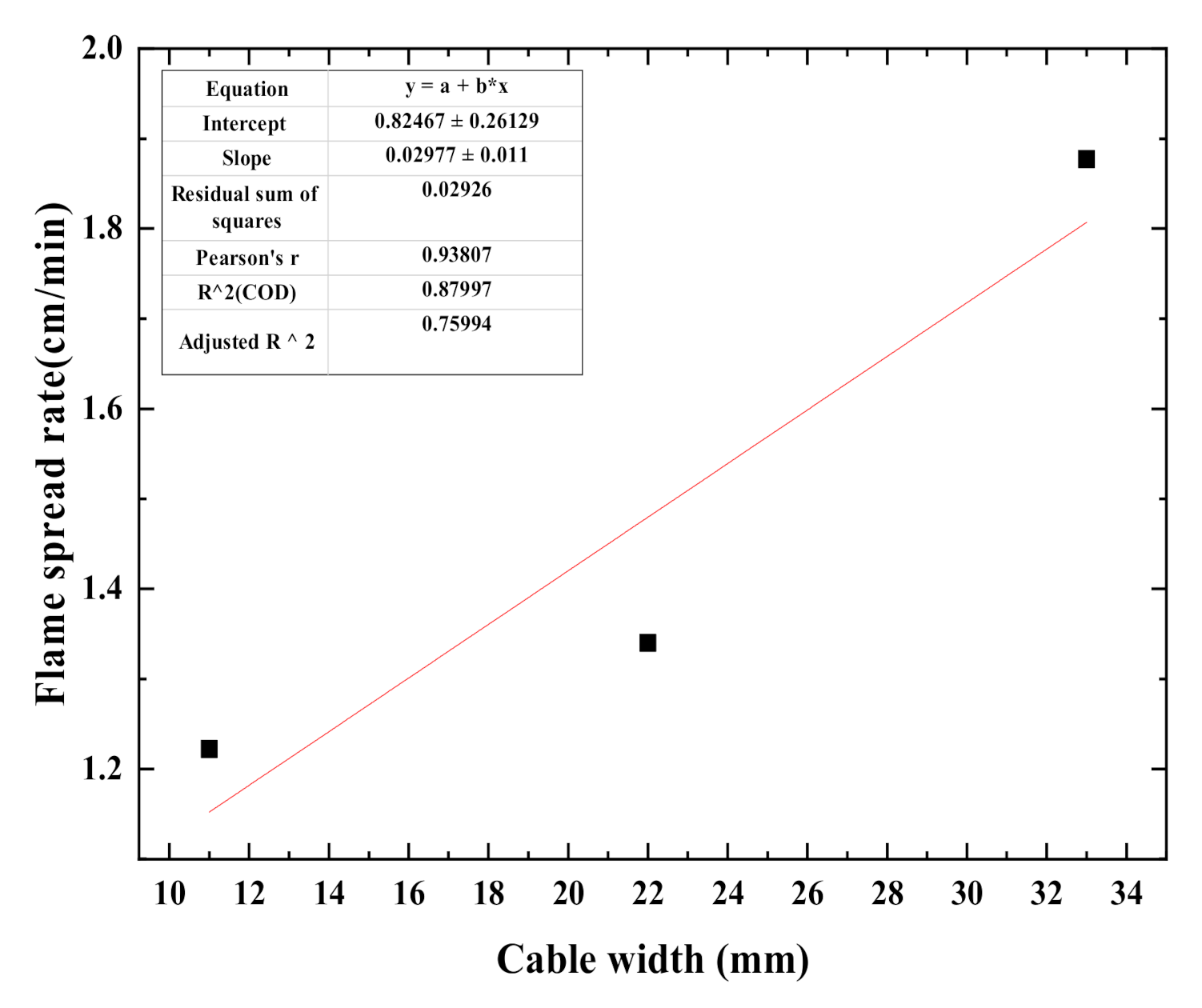
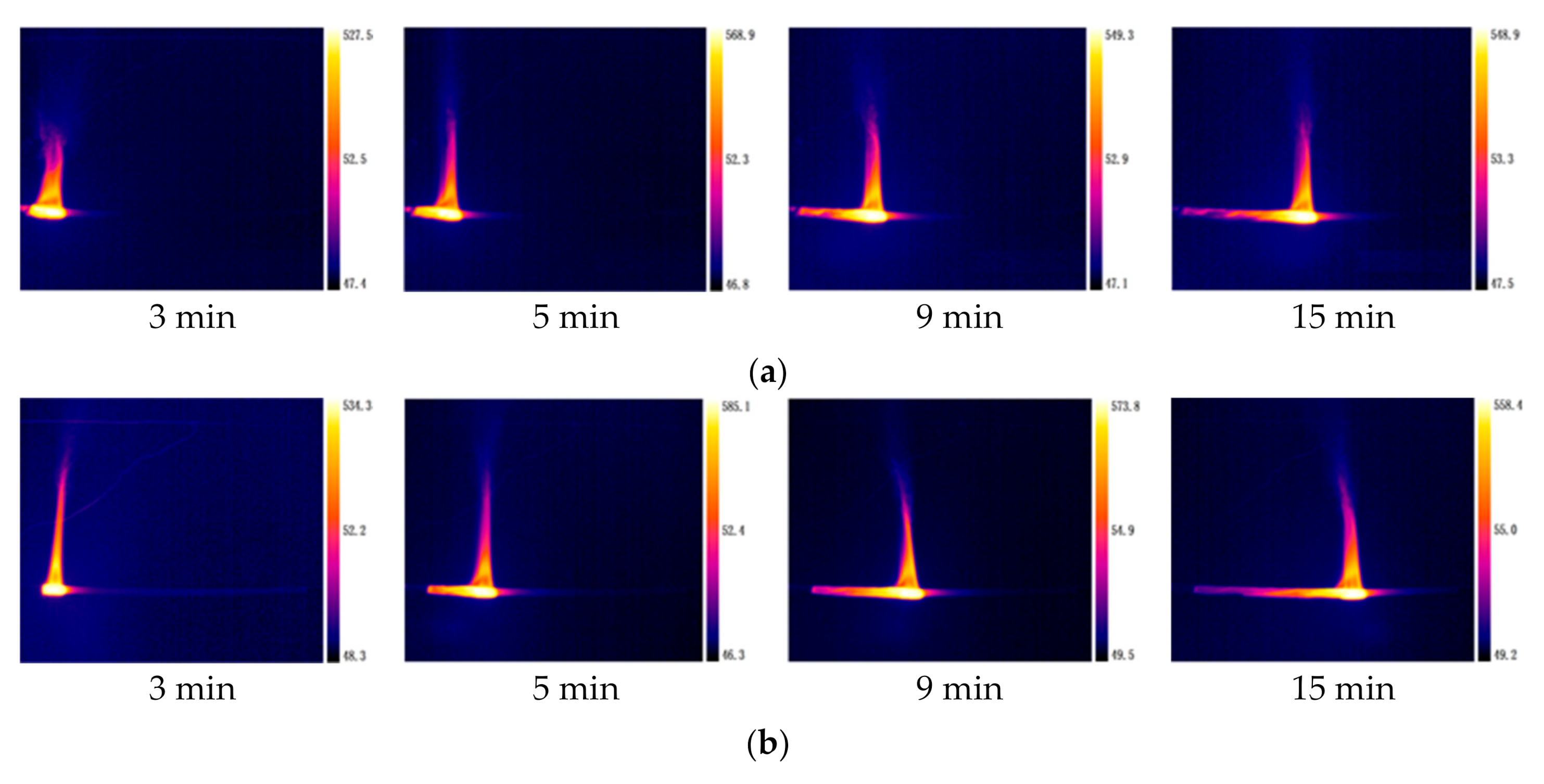


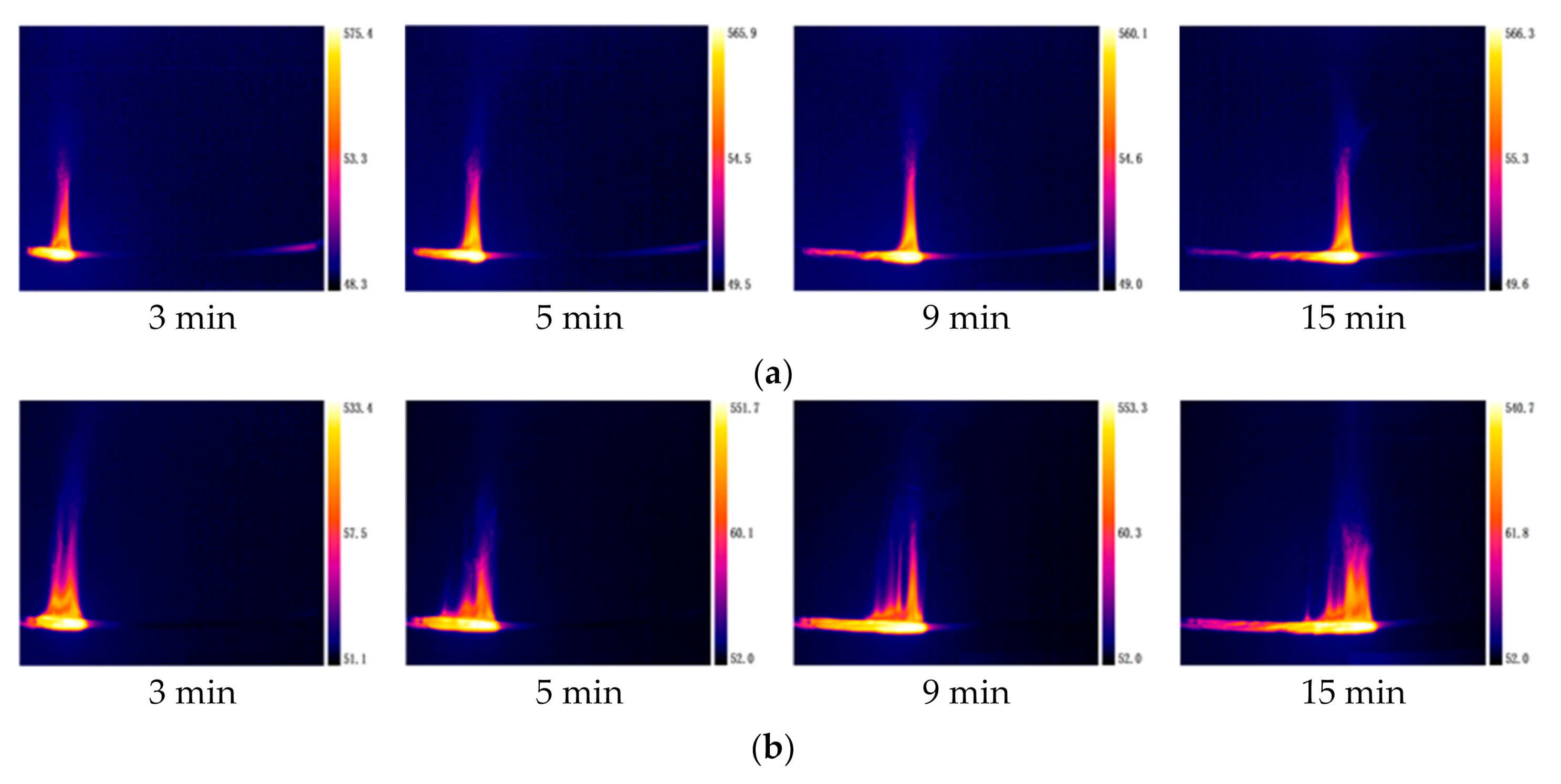

| Materials | Thermal Conductivity W/(m·K) | Density g/cm3 | Specific Heat Capacity kJ/(kg·K) |
|---|---|---|---|
| Copper | 387 | 8940 | 0.38 |
| Neoprene | 0.19 | 1250 | 1.7 |
| PVC | 0.2 | 1500 | 1.5 |
| Condition Number | Core Number | Number of Cables |
|---|---|---|
| 1 | two-cores | 1 |
| 2 | three-cores | 1 |
| 3 | four-cores | 1 |
| 4 | three-cores | 1 |
| 5 | three-cores | 2 |
| 6 | three-cores | 3 |
| Variance | Two-Cores | Three-Cores | Four-Cores | |||
|---|---|---|---|---|---|---|
| Oscillating Period | Stable Period | Oscillating Period | Stable Period | Oscillating Period | Stable Period | |
| Flame height variance | 0.153449 | 0.044898 | 0.131187 | 0.07525 | 0.062321 | 0.043459 |
| Flame width variance | 0.033124 | 0.020265 | 0.026224 | 0.021472 | 0.051584 | 0.011915 |
| Core Numbers | Two-Cores | Three-Cores | Four-Cores |
|---|---|---|---|
| Average flame height (mm) | 78.494 | 83.096 | 84.779 |
| Average flame width (mm) | 38.387 | 53.113 | 53.216 |
| Dimensionless flame height | 9.235 | 7.554 | 7.065 |
| Dimensionless flame width | 4.516 | 4.828 | 4.435 |
| Numbers of Cables | Single | Two | Three |
|---|---|---|---|
| Average flame height (mm) | 83.09 | 124.64 | 152.35 |
| Average flame width (mm) | 53.11 | 129.38 | 154.53 |
| Variance of flame height | 0.130447 | 0.489874 | 0.173649 |
| Variance of flame width | 0.066659 | 0.294971 | 0.318655 |
Publisher’s Note: MDPI stays neutral with regard to jurisdictional claims in published maps and institutional affiliations. |
© 2020 by the authors. Licensee MDPI, Basel, Switzerland. This article is an open access article distributed under the terms and conditions of the Creative Commons Attribution (CC BY) license (http://creativecommons.org/licenses/by/4.0/).
Share and Cite
An, W.; Tang, Y.; Liang, K.; Wang, T.; Zhou, Y.; Wen, Z. Experimental Study on Flammability and Flame Spread Characteristics of Polyvinyl Chloride (PVC) Cable. Polymers 2020, 12, 2789. https://doi.org/10.3390/polym12122789
An W, Tang Y, Liang K, Wang T, Zhou Y, Wen Z. Experimental Study on Flammability and Flame Spread Characteristics of Polyvinyl Chloride (PVC) Cable. Polymers. 2020; 12(12):2789. https://doi.org/10.3390/polym12122789
Chicago/Turabian StyleAn, Weiguang, Yanhua Tang, Kai Liang, Tao Wang, Yang Zhou, and Zhijie Wen. 2020. "Experimental Study on Flammability and Flame Spread Characteristics of Polyvinyl Chloride (PVC) Cable" Polymers 12, no. 12: 2789. https://doi.org/10.3390/polym12122789
APA StyleAn, W., Tang, Y., Liang, K., Wang, T., Zhou, Y., & Wen, Z. (2020). Experimental Study on Flammability and Flame Spread Characteristics of Polyvinyl Chloride (PVC) Cable. Polymers, 12(12), 2789. https://doi.org/10.3390/polym12122789







